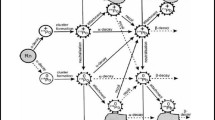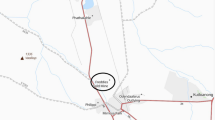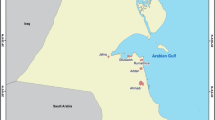Abstract
Atmospheric radioactive airborne released from several natural and artificial sources can travel for long distances and disperse in different directions. Both the physical and chemical characteristics of the atmospheric aerosols control this movement. The concentrations of 210Pb, 210Po, 7Be, 40K and 137Cs radionuclides in the ground surface air were determined in three particle sizes (2.4–10.2, 0.73–2.4 and less than 0.73 μm). High-volume air samples were collected from five different locations representing the five governorates of Kuwait using high-volume air samplers connected to a five-stage cascade impactor. The radioactivity concentrations of almost all fallout radionuclides were concentrated on the fine particle size fractions. The cosmogenic 7Be radioactivity level in all locations was relatively comparable and varied between 1.16 and 18.38 mBq/m3, with a geometric mean value of 6.80 mBq/m3. 137Cs was infrequently recorded with concentration varied between 4 and 14.3 μBq/m3. The geometric mean levels of the 210Po and 210Pb were 0.899 mBq/m3 and 1.03 mBq/m3, respectively, indicating that anthropogenic sources likely enrich 210Po. 40K was concentrated on large particle size fractions with a geometric mean value of 2.34 mBq/m3, reflecting the effects of the local dust sources. It was concluded that the radiological hazards due to airborne radioactive inhalation are low and can be negligible, where the annual estimated effective dose is about 64.0 μSv. The radioactive airborne measurements compose the base of estimating the aerosols residence time, resuspension rate of dust, soil redistribution and source apportionment, particularly the 210Pb and 210Po radionuclides.






Similar content being viewed by others
References
Aba A, Al-Dousari AM, Ismaeel A (2016) Depositional characteristics of 7Be and 210Pb in Kuwaiti dust. J Radioanal Nucl Chem 307(1):15–23
Achilleos S, Al-Ozairi E, Alahmad B, Garshick E, Neophytou AM, Bouhamra W, Koutrakis P (2019) Acute effects of air pollution on mortality: a 17-year analysis in Kuwait. Environ Int 126:476–483
Al-Azmi D, Sayed AM, Yatim HA (2001) Variations in 7Be concentrations in the atmosphere of Kuwait during the period 1994 to 1998. Appl Radiat Isot 55(3):413–417
Alolayan MA, Brown KW, Evans JS, Bouhamra WS, Koutrakis P (2013) Source apportionment of fine particles in Kuwait City. Sci Total Environ 448:14–25
Baeza A, Corbacho JA, Caballero JM, Ontalba MA, Vasco J, Valencia D (2017) Development of an advanced radioactive airborne particle monitoring system for use in early warning networks. J Radiol Prot 37(3):642
Balasubramanian R, Qian WB (2004) Characterization and source identification of airborne trace metals in Singapore. J Environ Monit 6(10):813–818
Brudecki K, Szufa K, Mietelski JW (2017) 131I age-dependent inhalation dose in Southern Poland from Fukushima accident. Radiat Environ Biophys 56(1):9–17
Carvalho F, Fernandes S, Fesenko S, Holm E, Howard B, Martin P, Phaneuf M, Porcelli D, Pröhl G, Twining J (2017) The environmental behaviour of polonium. International Atomic Energy Agency
Cho YH, Lee W, Chung KH, Choi GS, Lee CW (2007) Seasonal variation and activity size distribution of 7Be in ambient air. J Radioanal Nucl Chem 274(3):531–538
Chow JC, Watson JG, Lu Z, Lowenthal DH, Frazier CA, Solomon PA, Thuillier RH, Magliano K (1996) Descriptive analysis of PM2.5 and PM10 at regionally representative locations during SJVAQS/AUSPEX. Atmos Environ 30(12):2079–2112
Department of Mines and Petroleum (2010) Managing naturally occurring radioactive material (NORM) in mining and mineral processing—guideline. NORM-3.5 Monitoring NORM measurement of particle size: Resources safety. Western Australia: Department of Mines and Petroleum
Długosz-Lisiecka M, Bem H (2012) Determination of the mean aerosol residence times in the atmosphere and additional 210Po input on the base of simultaneous determination of 7Be, 22Na, 210Pb, 210Bi and 210Po in urban air. J Radioanal Nucl Chem 293(1):135–140
Dueñas C, Fernández MC, Cañete S, Pérez M (2009) 7Be to 210Pb concentration ratio in ground level air in Málaga (36.7 N, 4.5 W). Atmos Res 92(1):49–57
Eckerman K, Harrison J, Menzel HG, Clement CH (2012) ICRP publication 119: compendium of dose coefficients based on ICRP publication 60. Ann ICRP 41:1–130
Gründel M, Porstendörfer J (2004) Differences between the activity size distributions of the different natural radionuclide aerosols in outdoor air. Atmos Environ 38(22):3723–3728
Ioannidou A, Paatero J (2014) Activity size distribution and residence time of 7Be aerosols in the Arctic atmosphere. Atmos Environ 88:99–106
Ioannidou A, Manolopoulou M, Papastefanou C (2005) Temporal changes of 7Be and 210Pb concentrations in surface air at temperate latitudes (40 N). Appl Radiat Isot 63(2):277–284
Ismaeel A, Aba A, Al-Boloushi A, Al-Shammari H, Al-Boloushi O, Malak M, Al-Dabbous A, Al-Tamimi S, Al-Qadeeri G (2019) Estimating internal radiation dose due to radioactive airborne particles in Kuwait (KISR 15532). Kuwait Institute for Scientific Research, Kuwait
Jancsek-Turóczi B, Hoffer A, Nyírő-Kósa I, Gelencsér A (2013) Sampling and characterization of resuspended and respirable road dust. J Aerosol Sci 65:69–76
Jonkers G (1997) Characterization of NORM in the oil and gas production industry. Proc.of NORM
Lozano RL, Hernández-Ceballos MA, San Miguel EG, Adame JA, Bolívar JP (2012) Meteorological factors influencing the 7Be and 210Pb concentrations in surface air from the southwestern Iberian Peninsula. Atmos Environ 63:168–178
Masson O, Steinhauser G, Zok D, Saunier O, Angelov H, Babić D, Conil S (2019) Airborne concentrations and chemical considerations of radioactive ruthenium from an undeclared major nuclear release in 2017. Proc Natl Acad Sci 116(34):16750–16759
Mcneary D, Baskaran M (2007) Residence times and temporal variations of 210Po in aerosols and precipitation from southeastern Michigan, United States. J Geophys Res-Atmos, 112(D4)
Moore HE, Martell EA, Poet SE (1976) Sources of polonium-210 in atmosphere. Environ Sci Technol 10(6):586–591
Papastefanou C (2008) Radioactive aerosols. Radioactivity in the Environment, 12, pp. 11–58
Persson BR (2016) Global distribution of 7Be, 210Pb and, 210Po in the surface air (with Appendix AE). Acta Scientiarum Lundensia, 1
Persson BR, Holm E (2014) 7Be, 210Pb, and 210Po in the surface air from the Arctic to Antarctica. J Environ Radioact 138:364–374
Pham MK, Betti M, Nies H, Povinec PP (2011) Temporal changes of 7Be, 137Cs and 210Pb activity concentrations in surface air at Monaco and their correlation with meteorological parameters. J Environ Radioact 102(11):1045–1054
Ram K, Sarin MM (2012) Atmospheric 210Pb, 210Po and 210Po/210Pb activity ratio in urban aerosols: temporal variability and impact of biomass burning emission. Tellus Ser B Chem Phys Meteorol 64(1):17513
Sayed AM, Al-Azmi D, Khuraibet NA (2002) Measurements of 210Pb concentrations in airborne in Kuwait. Environ Monit Assess 79(1):47–55
Smith G (2014) UNSCEAR 2013 report. Volume I: report to the general assembly, annex a: levels and effects of radiation exposure due to the nuclear accident after the 2011 great east-Japan earthquake and tsunami
Steinhauser G (2018) Anthropogenic radioactive particles in the environment. J Radioanal Nucl Chem 318(3):1629–1639
Todorovic D, Popovic D, Djuric G, Radenkovic M (2005) 7Be to 210Pb concentration ratio in ground level air in Belgrade area. J Environ Radioact 79(3):297–307
Uğur A, Özden B, Filizok I (2011) Determination of 210Po and 210Pb concentrations in atmospheric deposition in Izmir (Aegean Sea-Turkey). Atmos Environ 45(27):4809–4813
United Nations Scientific Committee on the Effects of Atomic Radiation (UNSCEAR) (2010) Sources and effects of ionizing radiation: UNSCEAR 2008 Report to the General Assembly, Volume I, Scientific Annex B. United Nations
Valentin J (2007) The 2007 recommendations of the international commission on radiological protection. ICRP publication 103. Ann ICRP 37(2):1–332
Vallés I, Camacho A, Ortega X, Serrano I, Blázquez S, Pérez S (2009) Natural and anthropogenic radionuclides in airborne particulate samples collected in Barcelona (Spain). J Environ Radioact 100(2):102–107
Wallbrink PJ, Murray AS (1994) Fallout of 7Be in south eastern Australia. J Environ Radioact 25(3):213–228
Winkler R, Dietl F, Frank G, Tschiersch J (1998) Temporal variation of 7Be and 210Pb size distributions in ambient aerosol. Atmos Environ 32(6):983–991
World Health Organization (2006) WHO air quality guidelines for particulate matter, ozone, nitrogen dioxide and sulfur dioxide: global update 2005: summary of risk assessment (no. WHO/SDE/PHE/OEH/06.02). Geneva: World Health Organization
Wrixon AD (2008) New ICRP recommendations. J Radiol Prot 28(2):161
Funding
The Kuwait Foundation for the Advancement of Sciences (KFAS) had a major role in funding and supporting this project (Project Code P215-44WE-02, 2019).
Author information
Authors and Affiliations
Corresponding author
Additional information
Responsible Editor: Georg Steinhauser
Publisher’s note
Springer Nature remains neutral with regard to jurisdictional claims in published maps and institutional affiliations.
Rights and permissions
About this article
Cite this article
Ismaeel, A., Aba, A., Al-Shammari, H. et al. Activity size distributions of radioactive airborne particles in an arid environment: a case study of Kuwait. Environ Sci Pollut Res 27, 33032–33041 (2020). https://doi.org/10.1007/s11356-020-09367-y
Received:
Accepted:
Published:
Issue Date:
DOI: https://doi.org/10.1007/s11356-020-09367-y




